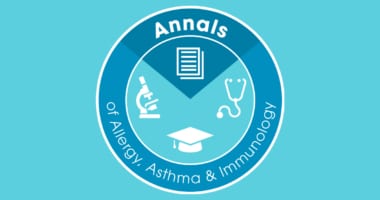 The February issue of the Annals of Allergy, Asthma and Immunology has a special emphasis on the atopic march. From the cover that depicts a typical march from dermatitis through food allergy to asthma and rhinitis, this is a message that bears repeating by all of us to researchers, patients and their families, payers and society at large. This concept has enjoyed a “practical home” with the practicing allergist-immunologist as we increasingly incorporate prevention strategies into our daily practices. Two articles in particular from this month’s Annals address this important concept and provide evidence to support further research into new mechanisms of pathophysiology and therapeutic strategy as well as better ways to identify those at greatest risk.
The February issue of the Annals of Allergy, Asthma and Immunology has a special emphasis on the atopic march. From the cover that depicts a typical march from dermatitis through food allergy to asthma and rhinitis, this is a message that bears repeating by all of us to researchers, patients and their families, payers and society at large. This concept has enjoyed a “practical home” with the practicing allergist-immunologist as we increasingly incorporate prevention strategies into our daily practices. Two articles in particular from this month’s Annals address this important concept and provide evidence to support further research into new mechanisms of pathophysiology and therapeutic strategy as well as better ways to identify those at greatest risk.
An outstanding review by David Hill, MD, PhD and Jonathan Spergel, MD, PhD, FACAAI presents evidence to support the concept of an “allergic march” based evidence such as the relationship between positive allergy skin testing in infants and small children and their risk of developing rhinitis and/or asthma. This clearly implicates the association and, although longitudinal data are presented, still leaves open the question of association vs. causation. The authors conclude with a provocative review of data from studies aimed at prevention with mixed results being presented. They conclude with the need for more research to better define these relationships to provide better care for our patients.
Another interesting article in this issue is by Mallory Gallant and Anne Ellis, MD, FACAAI who discuss the allergic march from the perspective of prediction strategies for the obvious purpose of disease prevention. They begin with a review of the genetics of atopy which has actually been utilized for many years. It is the recognition of the relationship between family history and risk for atopic disease. They support the concept that risk of atopic disease may begin in utero (perhaps reflective of maternal exposure) and thus can be recognized at birth. They review evidence for biomarkers contained in cord blood that might point to an infant with increased risk but demonstrate that no single biomarker has yet been identified. Finally, they review and emphasize a research strategy that employs enrollment of birth cohorts in what some might describe as an environmental case control model whereby children of different risk backgrounds live in similar environments and children with similar risk backgrounds live in different environments. This approach to study offers hope of better identifying risk from genetic and environmental exposure perspectives. Both of these are hallmark approaches to modern day precision medicine.
As always, we welcome comments on our journal. We want to challenge thinking and provide new and practical information that will allow all of us to better serve our patients who have allergy, asthma or immune-related diseases.
Gailen D. Marshall, Jr., MD PhD, FACAAI
Editor-in-chief

